Text
Improve How You Email (Research)

We’ve written about emails before on our blog and we wanted to write about them again today! Brian Dean and the people over at Backlinko did research on 12 million outreach emails and found some interesting data that really got our wheels turning.
What we wanted to do was throw in our two cents on a few of their findings that we felt could really translate well for small businesses along with how they relate to some of our previous blog posts! You can check out Brian’s big article on their research right here. It is loaded with great nuggets of info and we highly recommend it.
From their article, here is a summary of their 10 key findings:
1. The vast majority of outreach messages are ignored. Only 8.5% of outreach emails receive a response.
2. Outreach emails with long subject lines have a 24.6% higher average response rate compared to those with short subject lines.
3. Follow-ups appear to significantly improve response rates. Emailing the same contact multiple times leads to 2x more responses.
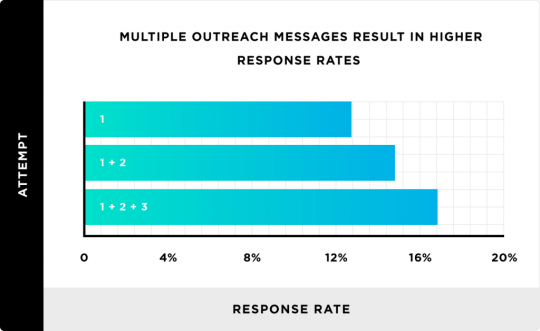
Source: Backlinko
4. Reaching out to multiple contacts can also lead to more success. The response rate of messages sent to several contacts is 93% higher than messages sent to a single person.
5. Personalized subject lines boost response rate by 30.5%. Therefore, personalizing subject lines appears to have a large impact on outreach campaign results.
6. Personalizing outreach email body content also seems to be an effective way to increase response rates. Emails with personalized message bodies have a 32.7% better response rate than those that don’t personalize their messages.
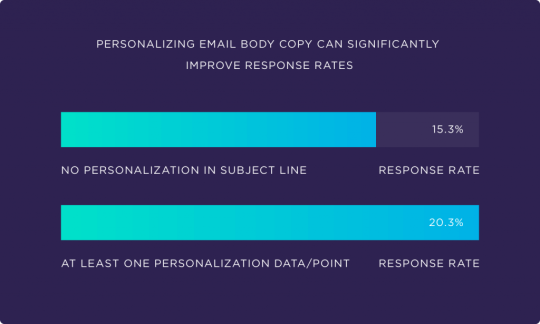
Source: Backlinko
7. Wednesday is the “best” day to send outreach emails. Saturday is the worst. However, we didn’t find an especially large difference in response rates between different days that messages were sent.
8. Linking to social profiles in email signatures may result in better response rates. Twitter was correlated with an 8.2% increase, LinkedIn an 11.5% increase, and Instagram a 23.4% increase.
9. The most successful outreach campaigns reach out to multiple contacts multiple times. Email sequences with multiple attempts and multiple contacts boost response rates by 160%.
10. Certain types of outreach get higher response rates than others. Outreach messages related to guest posting, roundups and links have an especially high response rate.
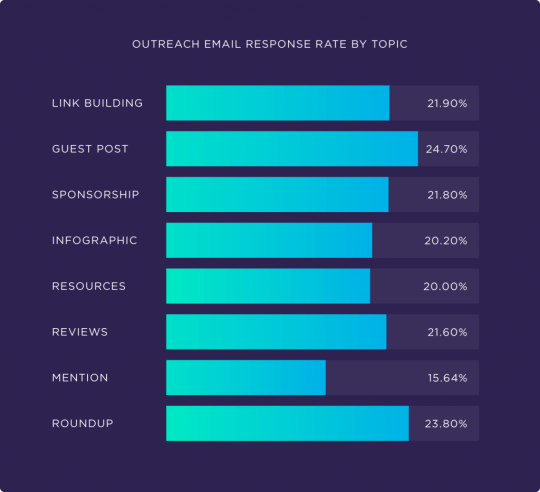
Source: Backlinko
These are all awesome and helpful, but the ones we want to spend a little more time on are numbers 3, 8, and 10. For the most part they all really speak for themselves based on the data they were extrapolated from. However, there are certain things that you can do as a small business that will help you make sure you are on the ball and sticking to habits that abide by these findings.
Follow-ups appear to significantly improve response rates. Emailing the same contact multiple times leads to 2x more responses.
This might go without saying, but yes, contacting people multiple times will lead to increase in responses. You have balance that fine line between showing you care and not being annoying. Often a big part of that difference is the content of your email. That is where personalization and many of the other points found in Backlinko’s study play a big role.
The other side of the coin is being able to keep track of everyone you email so you know who needs to be contacted again. This is huge! We’ve talked about automating your sales process in a blog post before on our site and discussed similar concepts. Finding a good CRM or any sort of scheduling tool can be really beneficial for keeping track of all communication that is coming from your business.
You want to be responsive with emails and always make sure you are following up, but you don’t want to spammy. Being able to properly schedule, automate, or just keep track of who gets what emails is so important for being able to do that.

Linking to social profiles in email signatures may result in better response rates. Twitter was correlated with an 8.2% increase, LinkedIn an 11.5% increase, and Instagram a 23.4% increase.
This can knock out two birds with one stone if you’re also really focusing on your social media output. It isn’t too far of a leap to assume that the more personalized and active your social media profiles are the more likely you generate a better response rate. We’ve talked a lot about social media on this blog before, discussing how businesses can use social media to build brand trust as well as other social media trends heading in to 2019.
Linking strong social profiles can do nothing but help you increase your email response rate. In turn, by having your social profiles linked to your outreach emails you’re now bringing in even more people to those profiles. It’s a good way to get a benefit on each form of communication.
It also seems with this particular statistic that Instagram shows a giant bump in response rate coming close to almost a ¼ boost in responses. Instagram is a social media app that is tailored for sharing images, a window in to your business, whereas platforms such as Twitter are more conversation focused. Linking to Instagram makes a lot of sense really, images are something that draws the eye and creates curiosity. Consumers will likely be much more interested in eye devouring your businesses instagram photos in a matter of seconds as opposed to taking the time to read your tweet timeline.

Certain types of outreach get higher response rates than others. Outreach messages related to guest posting, roundups and links have an especially high response rate.
This statistic just screams link magnets! We talked about a whole bunch of effective link magnets that help drive more conversions in one of our previous blog posts. We highly recommend checking that post out as it’s filled with great ideas to get your email marketing rolling.
Link magnets are what reel people back in and give them a reason to respond, subscribe, or buy from your email. If you can create link magnets that are easy to take part in and give consumers real value all while showing them that you know your stuff, then they are going to work for you! A good link magnet is the thing that adds that little extra juice to your email in order make it worth a customers time.
If your business is not currently using email marketing to its advantage then you need to start doing that now! Email is such a valuable tool for connecting with new and old customers you’re missing the boat by not trying to utilize its power. If you’re looking to get the ball rolling with email marketing in your business, give us a shout! We love helping small businesses and we can help you deliver the exact message you’re looking for!
Fire Away!
The post Improve How You Email (Research) appeared first on Apollo Marketing.
from Apollo Marketing http://bit.ly/2Dprppw via IFTTT
from WordPress https://searchengineoptimizationfrederick.wordpress.com/2019/04/19/improve-how-you-email-research/
0 notes
Text
Using Surveys With Your Business

In our previous article from last week we wrote about lead magnets and how they can help your business. One of the lead magnets that we mentioned was using surveys for your business. Surveys can be really useful if implemented properly and we wanted to go into why that is and how to do that! When done correctly surveys are really knocking out two birds with one stone.
On one hand, you can entice people to fill out surveys about your business by offering a reward for completing the survey. Attach rules at the end of the survey where a consumer must fill out information on themselves in order to submit the survey and what you have is an awesome lead magnet! It is important to note that the reward you offer must have a value that makes filling out the survey worth it.
On the other hand, if you develop a quality survey that asks customers thoughtful questions, then you are also gaining valuable insight in to your business based on the results. This is an opportunity for a big win if done correctly!
So how can actual survey results help your business? Americanexpress.com lists five different ways that surveys can help your business. They are market analysis, tracking performance, customer follow-up, customer demographics, and crowdsourcing.
1. Market Analysis
Conducting surveys allows you to get an idea of what your consumers want from your products or what they think is important. Information such as this allows you to plan ahead and create or improve products and services that consumers want to see.

2. Tracking Performance
You can use surveys to simply find out if customers had a good experience with your business. This is a good way to keep track of how you and your staff are performing.
3. Customer Follow-Up
Right after completing a sale, a customer follow up survey is a great way to see if the customer’s needs were met to their satisfaction and it shows the customer that you care. Showing you care builds trust and you want everything to go back to trust!

4. Customer demographics
Surveys that ask consumers questions about themselves will do two things for you. It will strengthen that bond of trust and show consumers that you want to gear your products to fit their potential needs and lifestyle. It will also provide you valuable data that shows who your consumers are and what they need. Knowing more about your consumer base allows you do a ton in terms of developing new services, relationships, and strategies.
5. Crowdsourcing
Asking your crowd what their opinion is on certain things really isn’t a bad idea. Trying to decide on a new logo or new product? Asking consumes to vote between choices is a pretty good way to see what people will like. In return people also see a business that cares about what their consumers have to say. It’s a win-win.

What Makes A Survey Good?
When you’re going to create a survey you can’t just jot down questions and then slap it online expecting the best results. The better your survey is written then the more informative the results will be. Not paying attention to detail opens up the possibility of consumer confusion which may create unreliable survey results.
Writing
Surverymonkey.com is one of the many survey service providers on the internet to choose from. They have a great article on their website in which they share some tips for writing effective surveys. We are going to share their tips for writing a good survey below and discuss each of them!

1. Focus On Asking Closed-Ended Questions
Asking too many open-ended questions can lead to consumers abandoning a survey before completing it because of all the effort required to answer the questions. Survey Monkey recommends asking no more than 2 open-ended questions on a survey and to leave them until the end so you can collect all the other info beforehand.
2. Keep Your Survey Questions Neutral
If you’re conducting a survey you want to get the most reliable results possible. This means you do not want to lead consumers to feel one way or another based on how your question is worded. Human psychology is a sneaky powerful thing and you would be surprised how much sentence structure can have an effect on how people respond.
Survey Monkey uses a more obvious example to demonstrate the differences between a leading question and a neutral one. Their example for a leading question is “We think our customer service representatives are really awesome. How awesome do you think they are?” Their example for a neutral question is, “How helpful or unhelpful do you find our customer service representatives to be?”
See the difference?

3. Balance Answer Choices
Similar to keeping your questions neutral you also need to make sure that consumers are provided with answer options that are fair and balanced. If you ask a question about the helpfulness of a product or service and the only options to answer from are “extremely helpful, very helpful, or helpful” then the customer has no opportunity to answer honestly. If they had a bad experience what are they supposed to answer?
4. Don’t Ask Two Things At The Same Time
This is what is known as a double-barreled question. You don’t want to confuse consumers by asking them questions that involve two different topics. An example of a double-barreled question would be, “How would you rate our product quality and our delivery time?”
Product quality and delivery time are two different things and can’t both be answered at the same time accurately. If one was bad and one was good then there is no way for a consumer to express that if they are asked in the same question.
5. Vary The Questions You Ask
This might go without saying, but do not ask the same question over and over again with different phrasing. This will just make people leave the survey, or even worse, just click random answers to get through to the end. This is called “straight lining” and it is a killer to survey reliability.
You don’t want people to go into autopilot mode so it is important to vary the types of questions you ask and where in the survey you ask them. This keeps the survey fresh and less monotonous.

6. Make Your Questions Optional
Forcing people to answer every question in a survey is just going to make some of them stop taking the survey altogether. There might be a possibility that some people will not know the answers to certain questions you pose so it is better to make most questions optional if you can.
Now not every question can be optional as there are some questions that may be very important to the results of the survey. For example a question asking someone their age may be important to know for your particular survey so you can get an accurate idea of what kind of consumers respond to your products. If no one is answering how old they are then your data would be hard to interpret once you get all of the results back.
7. Test It Out
Always survey your close affiliates in a test survey before doling it out the masses. They’ll be able to find mistakes and raise questions that you couldn’t thanks to a fresh pair of eyes.

Survey Length
You also want people to actually fill out your survey. Offering a reward for completing the survey as we mentioned above is a great way to encourage more responses. You also don’t want to make your survey too long as this will dissuade people from filling it all out. Shorter surveys are more conducive to a better response rate.
Survey Monkey has another very informative article that looks at research on survey length and response times that they conducted. What they found is pretty interesting!

Survey Monkey
One thing to note is that the more questions there are then the less time people spend responding to each question. Part of this depends on the type of question, but ask yourself, do you want people to spend more time answering your questions or less? If you’re looking to get thoughtful answers that may lead to reliable results then you probably want people spending more time thinking about your questions.
Survey Monkey also found that abandon rates increased for surveys that took more than 7-8 minutes to complete. They also found that the tolerance for lengthier surveys was higher for surveys that were work or school related and less so for surveys that were customer related. So if you’re a business surveying your customers we’d advise keeping it short and to the point!
Now You’re Ready
Surveys can be super beneficial to a business and we hope this article helps you with creating surveys of your own! As long as you take the time to create a thoughtful survey then you will likely gain thoughtful feedback in return. That is the ultimate goal and the crazy part is that it all stems from the idea of a simple lead magnet!
If you’d like to know more about how lead magnets can be combined and utilized to help your business grow then give us a call! We’re the experts and we love helping small local businesses grow and reach their potential.
I’m Ready To Find Out More About My Business!
The post Using Surveys With Your Business appeared first on Apollo Marketing.
from Apollo Marketing https://ift.tt/2uLSVsS via IFTTT
from WordPress https://searchengineoptimizationfrederick.wordpress.com/2019/04/03/using-surveys-with-your-business/
0 notes
Text
15 Lead Magnets To Drive More Conversions

Every marketer needs to utilize strong lead magnets. Every business needs to utilize strong lead magnets. Every brand needs to utilize strong lead magnets. Whoever you are, finding out what makes strong lead magnets and which ones work for your business is super important. In this post we’ll be going over what a lead magnet is and why they matter. Then we’ll give you a bunch of examples of effective lead magnets! Sounds good? Okay!
So lead magnets, what are they? As their name suggests, lead magnets are mechanisms used to attract new leads. They are at their most effective when being used in email marketing in order to gain more email subscribers or contact information from potential customers. Lead magnets are typically free pieces of digital content that are offered up for some form of exchange with a customer. For example, a customer can download a pdf or special report in exchange for their contact information. Lead magnets are usually in the form of digital content, but they don’t always have to be. For example a free 1 on 1 consultation offering wouldn’t be considered digital content but it is a great example of a lead magnet.

Why does every business need to use them? It’s simple, if you want to generate leads online then you have to be using lead magnets. If you’re trying to get emails from people to grow your email list, people aren’t just going to hand over their email addresses without getting something in return. Offering some sort of special reward to consumers raises the likelihood that they will provide you with more information or subscribe to your list.
OptinMonster.com lists seven traits that all good lead magnets have. Lead magnets should solve a real problem, promise one quick win, be super specific, be easy to digest, have high value, be instantly accessible, and show your own expertise. To sum all of that up, you want your lead magnet to provide easy and instant value to a consumer. Make it a win-win!
1. Checklists
Check lists are awesome because they are easy to consume and they are easy to create! You can use a checklist to summarize a large blog post or any other types of information you want to share with clients.

2. Resource List
Another type of list. What makes resource lists so great is that they are a one stop shop for all types of information on a certain topic and you’re saving someone elses time on research. People like saving time and they like getting value.

3. Coupon Codes & Special Discounts
We think this type of lead magnet goes without saying. Who doesn’t love a deal or discount? No one, that’s who. Offering special discounts that are only available to people if they fill out certain info is a great way to generate more potential leads.

4. Calculator
In situations where a potential consumer may have questions about price or how price works in your business model, a calculator is a great lead magnet to use. Here at Apollo we actually use a lead calculator for our lead generation services to determine monthly costs for businesses based on their lead conversion rates.

5. Infographic
Ah yes, an infographic! Infographics are great ways to provide a ton of information in a presentable and digestible way. They are definitely much more appealing to the eye than just regular text on a PDF. They aren’t so hard to make either contrary to what you make think. Websites like Piktochart.com make it easy to piece together a great looking infographic from scratch.
There is just something about an infographic that is appealing to people as well. As soon as you see one it’s almost like you have to read it. There is just this urge that exists driven by curiosity.

6. 1 on 1 Consultations
Offering a free consultation to get your foot in the door with a potential client is a tried and true method for generating new leads and therefore makes it a great lead magnet! You can do free consultations or you can bundle consultations with discount offerings and other lead magnets. Whatever floats your fancy! Try different combinations and see what works best for your business.

7. Free Quote
A free quote is an alternative to a 1 on 1 consultation that can work just as well and maybe even better dependent upon your business. With a free quote you can ask for more information than you would typically be able to when compared to other lead magnets. Most places that utilize free quotes start off by asking for the person’s zip code and then asking for more information from there.

8. Giveaway Contests
If there is anyone in this world that does not like free stuff then I want to meet them and study them. Doing giveaways is a great way to get more eyeballs and collect information from your consumer base. Something like a sign-up form that enters the consumer in to a giveaway contest is both simple and efficient! You just need to make sure the giveaway item or service is something that people are interested in.

9. Newsletter
A newsletter is a great lead magnet to use and another one that us here at Apollo utilize! Our newsletter is sent out at the end of every month and it features the best blog posts from that month all in one email. Newsletters can contain many things and this is just one example for using them effectively.

10. Quiz
Contrary to your memory of quizzes in grade school, quizzes can actually act as a form of entertainment inside of a lead magnet. If you have the right quiz with the right title, it can easily entice someone to spend a little extra time on your site and take your quiz to satisfy their curiosity. Basically, they take the quiz and then they have to enter information in order to get the results.

11. Survey
Surveys are necessary for performing good research on your clientele, but they can also be strong lead magnets. If you optimize your survey to ask people who have been on your site for a long time about their experience then you may be surprised with how many responses you get. You can even combine surveys with other forms of lead magnets, such as giveaways. For example, “Fill out this survey and be entered for a chance to win this prize!”

12. Facebook Groups
We talked about the power of using different types of Facebook groups in one of our recent blog posts about building trust on social media. These same Facebook groups can also be utilized as lead magnets. Present these groups to people and show them there is a wider community experience out there for them that is based around your product or business. It’s a great way to bring in new potential leads that may become loyal as well.

13. Free Trial
The free trial is a perennial powerhouse when it comes to lead magnets. Give people a free taste by allowing them to sign up for something with their info and in exchange granting them limited time access at no cost. It’s definitely a dependable lead magnet.

14. Guides
Guides are educational tools in the form of lead magnets. Essentially, anyone who is visiting your site already has some sort of interest in your business or, at the very least, in the service that you provide. The idea is to nurture that interest and develop it into something more through building trust and showing that your business knows your stuff. Guides are a great way to do this and educate consumers on why they should use your business for their needs.

15. Gated Content
We imagine you have probably seen all of these lead magnets somewhere on the internet, but maybe none of them as much as gated content. Gated content is just special content that consumers have to provide extra information for in order to consume. You want your most enticing content to be behind these gates. If consumers like all of your non-gated content then they may feel enticed to fill out more information in order to get even better content.

Lead The Way
All of these lead magnets can be super helpful to your business by bringing in new leads, establishing trust, and building a strong brand reputation. There are also tons of other lead magnets that we didn’t even scratch the surface on. There is a lot of room to get creative with lead magnets and you can go in many different directions with the right ideas.
If lead magnets are something that you’ve seen before and always wanted to try, but didn’t know where to start, now might be a great time! If you want help on how to best utilize the right lead magnets for your business then contact us! This stuff is our bread and butter and would love to help you out!
Show Me The Lead!
The post 15 Lead Magnets To Drive More Conversions appeared first on Apollo Marketing.
from Apollo Marketing https://ift.tt/2JQamCL via IFTTT
from WordPress https://searchengineoptimizationfrederick.wordpress.com/2019/03/28/15-lead-magnets-to-drive-more-conversions/
0 notes
Text
It’s All About Stories: 5 Tips For Storifying Your Social Platforms

In last week’s blog post we took a look at building trust as a social media marketing trend for 2019 pointed out in Hootsuite’s social media report. The report is compiled from the combination of a survey of 3,255 Hootsuite business customers that was conducted in Q3 of 2018 and other source materials. This week we want to look at another trend that Hootsuite see as on the rise in 2019. That trend is stories, or what they label it as, storifying social. If building brand trust is the foundation, then using stories for your brand is a key building block to developing that foundation of trust.
Stories were first seen on Snapchat, the mobile messaging app that allows you to communicate with your peers through short pictures or videos that can only be viewed once and vanish after being viewed. Snapchat added stories to their platform in October 2013 and their popularity took off right away. Stories on Snapchat were basically a way to broadcast pictures or video to all of your followers or friends at one time rather than just individually messaging those same people.
This formula for stories was essentially the same formula that Instagram and Facebook would use when they launched stories on their platforms. Instagram launched stories in later 2016 with Facebook following shortly after in early 2017. WhatsApp, another social messaging platform joined the stories fray as well when they launch WhatsApp Status in 2017.

Since Facebook and Instagram are much more robust social media platforms than Snapchat and WhatsApp, which at their cores are messaging apps, stories from Facebook and Instagram have a little more meat on their bones for businesses looking to find new audiences and appeal to their current ones. Your business probably has a lot more people looking at your Facebook page and Instagram page than there are following your Snapchat or WhatsApp, if you even have a business Snapchat or WhatsApp page.
Let’s dig in to the data that Hootsuite lays out for us. There are over 150 million daily active users for Facebook stories plus an additional 70 million users on Facebook messenger. There are 300 million daily active users on Instagram alone and 64% of respondents to Hootsuite’s survey said they have either implemented Instagram stories in to their social strategy or plan to do so within the next year.
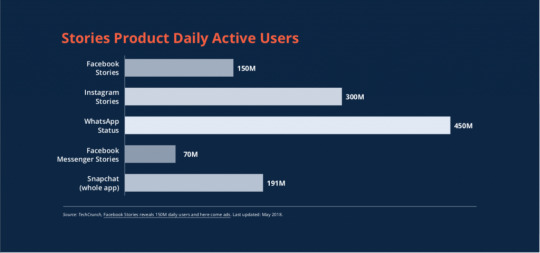
Source: Hootsuite
Hootsuite cites Block Party, Beyond the News Feed findings that 4 out of 5 major brands are already starting to use the stories format and that stories are now growing at a rate 15 times faster than feed-based sharing. So what makes stories so different? For one, stories are all visual and can be consumed quickly by consumers. Hootsuite says they are “real, immediate, and intensely personal.” I really like this way of putting it. Stories are really just flashes in the pan that take place in the palm of a consumers hand. Stories that are off the cuff and more intimate seem to perform better than highly edited productions. It’s all about being more personable, which relates back to our last post about brands building trust!
Hootsuite laid out some great tips for how to get started with stories and we are going to take a look at them below.
1. Start Now
You have to just jump in and get started right now. Even if you have no idea what you’re doing, stories are supposed to be natural and feel impromptu, what better way to get that than by learning on the fly. They are easy to make, all you need to do is pick up your phone and start recording. Waiting to become a master before starting isn’t worth the time. Test and experiment!

2. Be Story Specific
Like we said above, stories should be personal and natural. Hootsuite tested the performance between live action stories with real people and animated stories and found that live action stories were significantly better. Creating stories with people about your brand that can only be seen in one place, in your stories!
One way to treat stories is like your business’s very own behind-the-scenes look in to what is happening. You’re creating a whole new angle to spotlight your brand, not a new vehicle to regurgitate your other postings.

3. Change It Up
Test different ways to build out stories. You can do a behind-the-scenes like we said above but you could also try out tutorials or answering questions that you get asked from people. Variety is a good thing and as long as that variety always include personality and realness then you succeed in continuing to build trust with your consumers.

4. Use The Highlight Feature
After 24 hours stories disappear forever. However, maybe sometimes you don’t want that to happen. With the highlight feature you can handpick stories to be displayed in the highlights section for as long as you want them to be. The highlight feature is great for serializing certain stories, centering certain stories around a theme and bringing them together in a collection, or for longer form promotional campaigns.

5. Get Everyone Involved
The best way to extract a human element out of your social stories is to get everyone in your business involved with it. To expect one person to be able to breath all of the life in to a good social story strategy and bring everything to the table is just unreasonable. Sure, someone can and should be the figurehead of the operation, but getting all parts of your team to contribute ideas and add their own personal blends will help bring your stories to life and get that inside feel that you want them to. Stories need to be a window in to your business, your whole business!

Our Thoughts
Stories may be the number one way to build brand trust in 2019. You should want to get the ball rolling now! You don’t need to be an expert to start today. You can treat this article as crash course guide to help in your new endeavor but the ultimate thing you should take from this is to be real with stories.
If you’d like to know more about social media marketing, or what digital marketing in general can do for you as we head into 2019, contact us! 2019 is the year of the story, and we would love to help you tell yours.
I Want My Story Told!
The post It’s All About Stories: 5 Tips For Storifying Your Social Platforms appeared first on Apollo Marketing.
from Apollo Marketing https://ift.tt/2FnerZU via IFTTT
from WordPress https://searchengineoptimizationfrederick.wordpress.com/2019/03/20/its-all-about-stories-5-tips-for-storifying-your-social-platforms/
0 notes
Text
Google Broad Core Update: What You Need To Know

On March 12th, and running through March 13th, Google released a large update to their search algorithm. As we wrote about in a previous blog post on our site, sometimes it is just anyone’s best guess as to whether there was an update or not. Google doesn’t always say when they’ve updated their algorithm so sometimes it is just a matter of analyzing the data closely to see for yourself.
This update was different however as Google confirmed in a tweet on March 13th that there was in fact a large algorithm update. Now, Google’s rare public announcement aside, it was pretty apparent that something big had been changed in the past few days as buzz about large ranking fluctuations began to spread around social channels.
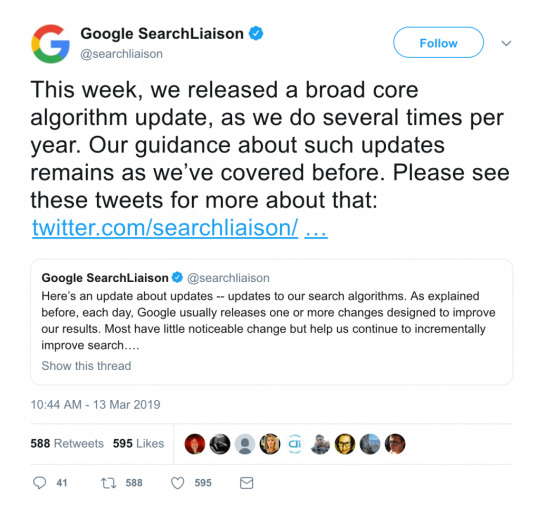
Source
In a great article about the latest Google update, the people over at cognitiveseo.com did some digging and found some major drops in rankings on popular keywords with high search volumes to backup what everyone has been saying online about their own rankings.
Cognitive SEO noted that they only found a few situations where websites declined in SERP on a just a few keywords. Most sites they looked at dropped rankings in half or more than half of the keywords they wanted to rank in.

Source
Why Should You Know?
So why is it important to be aware of these algorithm updates? The basic answer is so you don’t misidentify the source of your rank fluctuations. There isn’t anything you can do to “fix” your rankings during these broad core updates that Google rolls out, but knowing that the update has happened tells you that it isn’t something that you are doing on your end.
In series of tweets in late 2018, Google stated, “Here’s an update about updates — updates to our search algorithms. As explained before, each day, Google usually releases one or more changes designed to improve our results. Most have little noticeable change but help us continue to incrementally improve search… Sometimes, we make broad changes to our core algorithm. We inform about those because the actionable advice is that there is nothing in particular to ‘fix,’ and we don’t want content owners to mistakenly try to change things that aren’t issues… We understand those who do less well after a core update change may still feel they need to do something. We suggest focusing on ensuring you are offering the best content you can. That’s what our algorithms seek to reward.”

What Should You Do?
According to Google, you don’t need to make any sweeping changes to your site. However, in our opinion, you should still cover your tracks. Take an algorithm update as a good time to check what you’re doing and make sure you’re still on the right track. Make sure your content is relevant and optimized, make sure your site is performing well, check your backlink profile, and check your ranking positions, among other things. Basically, check yourself before you wreck yourself!
If you need help checking yourself and making sure you’re not wrecking yourself get in touch with us to find out more about what SEO is and what it can do for your business and your website. There is a whole world out there to explore and we’d love to help you take the trek or at the very at least start to learn more about it!
I’m Ready For The Next Step!
As for what this algorithm update changed, it is still too early to tell. When we know we’ll make sure to provide an update, but research still needs to be done across the broader SEO community in order to pinpoint what the changes are.
The post Google Broad Core Update: What You Need To Know appeared first on Apollo Marketing.
from Apollo Marketing https://ift.tt/2HxAnEc via IFTTT
from WordPress https://searchengineoptimizationfrederick.wordpress.com/2019/03/14/google-broad-core-update-what-you-need-to-know/
0 notes
Text
3 Things That Build Brand Trust
Hootsuite just recently released their Social Media Trends 2019 report and it is full of fantastic information. The report is based on a survey of 3,255 Hootsuite business customers that was conducted in Q3 of 2018. Based on the data collected plus other sources and reports, Hootsuite has mapped out what they feel like will be the most impactful social media trends of 2019 and talked about them extensively.
We wanted to carve out some space in our blog to talk about some of trends they pointed out in their report and share some of our own thoughts on them. The trend pointed out by Hootsuite that we wanted to talk about in this post is brands looking to rebuild trust in 2019.

After a tumultuous 2018 for big social media brands such as Facebook and Twitter, it seems trust in social media is at an all time low. Topics such as data privacy, ethics, transparency, and security regarding social media platforms all came in to question in 2018 and many of those questions were left unanswered. Congressional hearings, public debates, and scathing articles have left many waiting on the next moves from the tech giants over in Silicon Valley. Companies like Facebook and Twitter have a tough road ahead of them as they look to set themselves up on the correct path in a rapidly changing digital society.
All this controversy surrounding these different platforms brought an erosion of trust. Citing Edelman’s 2018 Trust Barometer Report, Hootsuite stated that 60% of the people they surveyed no longer trust social media networks. The thing is, just by nature, if people are losing trust in some of the vehicles that brands use to deliver their messaging then some trust may decay in brands themselves just by relation.
60%
Percentage of People Who Know Longer Trust Social Media Networks
When we then take a dive deeper in to Edelman’s 2018 Trust Barometer Report that Hootsuite cited, a few things come to light. According to Edelman, 48% of people say it’s a brand’s own fault if its advertising appears next to hate speech, violent or sexually inappropriate content. Another 47% believe that points of view that appear near a brand’s advertising and marketing are an indication of that brand’s values. 54% are uncomfortable with marketers retargeting in-store purchases and 49% say they are not willing to sacrifice some of their data privacy in return for a more personalized shopping experience.
With all this in mind it is so important for brands and businesses to always be looking for ways to build trust with their consumers. This has always been an important thing in general, but maybe now more so than ever.
So how do you build trust? Hootsuite laid out some great ideas and strategies for how to do this. We wanted to give some thoughts on the strategies that we felt could best be utilized by local businesses. Each of these strategies are easy to start and cost effective making them great starting blocks for building up trust in your business.
Want to learn what we can do to help grow your business?
Yes Please!
Create a Brand Hashtag For Instagram Aligned With Community Values.
Hootsuite suggests creating a short, simple hashtag that is easy to remember and unique to your brand. Then encouraging those people to use those hashtags when they share or use your product online in order to build more of a purpose around your brand and start to connect your customers in different ways. You’re basically encouraging user generated content from your customer base in order to build a personality and atmosphere around your brand.
Hootsuite uses the example of Herschel Supply Co. who has a hashtag #welltravelled and they encourage people to share pictures of their products while out on hikes and adventuring.
Making a hashtag is easy and only takes a little bit of brainstorming. We think this is an easy and even fun idea to breathe some life in to your business!

Build a Facebook Group Around a Core Audience Interest
If you have a Facebook business page, Hootsuite suggests creating a Facebook group to compliment it. Your Facebook business page will offer general information while your group will target superfans and more specific interests around your business. The idea is to create a space where your hardcore fans can engage with each other. You don’t want to flood your group with sales pitches and fluff but just allow it to be a medium where people can share ideas.
You can even take it a step further and alter the exclusivity of the group. You can make a group public, private, or even make it secret. A secret group is a group that can not be searched up on Facebook and the only way to join it is to be invited by an existing member of the group. Dependent on the business or brand, either of these options would be useful. Creating these groups develops a feeling of exclusivity from the consumer and sets off those intrigue receptors in people’s brains. It is good to make people feel like they are a part of something bigger than themselves!

Run Monthly Facebook Live Q&A Sessions Around Commonly Asked Questions
Monthly Q&A sessions through Facebook Live is a fantastic way to build brand trust and so easy for local businesses to do! It is all centered around authenticity. Just get your phone and start filming yourself talk about whatever it is you want to talk about. No scripts or anything, just roll with it. Talking about common questions you get about your business is a good way to find something to talk about, but you can really talk about anything! It is all about bringing a more human aspect to your brand.
They are also great outlets for plugging in your exclusive Facebook group! Something like, “Hey, if you liked this and want to learn or hear more then check out our special Facebook group that can be found here.” This way you’re tying everything together and really creating an authenticity around your brand.

Our Thoughts
Each of these strategies are specific and actionable. Begin them right away and you’ll be able to start creating a life and image around your business. On top of these specific actions we would also advise businesses to always practice being transparent and engaging. If you’re honest and open with your consumers then they don’t have a reason not trust you! All of this extra stuff just strengthens that bond even more. Be real because you are real.
If you are looking for help building an image around your brand or business and want to learn more about what can be done or how we can help you, contact us! We love helping local businesses be the best versions of themselves that they can be and would love to learn about your business and the people behind it.
Click Here To Learn More!
The post 3 Things That Build Brand Trust appeared first on Apollo Marketing.
from Apollo Marketing https://ift.tt/2tVEdiz via IFTTT
from WordPress https://searchengineoptimizationfrederick.wordpress.com/2019/03/07/3-things-that-build-brand-trust/
0 notes
Text
3 Things We Learned About Content Marketing

During our typical internet perusing here at Apollo Marketing we came across an awesome article by Brian Dean over at Backlinko.com. Brian’s article is basically a fact dump about their research on content marketing. Brian, Backlinko, and their data partner BuzzSumo analyzed 912 million blog posts to research and write the article. 912 million!! Then they shared what they learned.
We found all of it to be really interesting and useful in a number of different ways. What we wanted to do in this post was talk about some of Brian’s findings that jumped out to us the most.
Before we do that though we’ve listed a snippet from Brian’s article for you to take a look at that summarizes all of his findings. We’ve highlighted the ones that we find interesting and plan on talking about, but as you can see there are a bunch of other key findings as well. We definitely recommend checking out his whole article as it is chock full of awesome stuff!
Backlinko’s Key Findings
Long-form content gets an average of 77.2% more links than short articles.Therefore, long-form content appears to be ideal for backlink acquisition.
When it comes to social shares, longer content outperforms short blog posts. However, we found diminishing returns for articles that exceed 2,000 words.
The vast majority of online content gets few social shares and backlinks. In fact, 94% of all blog posts have zero external links.
A small percentage of “Power Posts” get a disproportionate amount of social shares. Specifically, 1.3% of articles generate 75% of all social shares.
We found virtually no correlation between backlinks and social shares. This suggests that there’s little crossover between highly-shareable content and content that people link to.
Longer headlines are correlated with more social shares. Headlines that are 14-17 words in length generate 76.7% more social shares than short headlines.
Question headlines (titles that end with a “?”) get 23.3% more social shares than headlines that don’t end with a question mark.
There’s no “best day” to publish a new piece of content. Social shares are distributed evenly among posts published on different days of the week.
Lists posts are heavily shared on social media. In fact, list posts get an average of 218% more shares than “how to” posts and 203% more shares than infographics.
Certain content formats appear to work best for acquiring backlinks. We found that “Why Posts”, “What Posts” and infographics received 25.8% more links compared to videos and “How-to” posts.
The average blog post gets 9.7x more shares than a post published on a B2B site. However, the distribution of shares and links for B2B and B2C publishers appears to be similar.

Long-Form Content Is Ideal
According to Backlinko and their team, it appears that long-form content is much better than shorter pieces of content when it comes to generating social shares. However, anything more than 2,000 words and those numbers start to dip back down again. So content that is best for producing social shares falls in between the 1,000 to 2,000 word range.
It is shown that the same can be said for long-form content and backlinks as well. Backlinko’s research shows that long-form content gets an average of 77.2% more links than short articles. However with long-form content aimed at generating backlinks, the more words the better. There isn’t a drop after 2000 words like there is in social sharing and it seems that the bigger the article the higher the likelihood of generating backlinks.
Of course the article still needs to have a balance of quality and quantity. So adding fluff to boost your word count is a no no. Long articles designed for attracting backlinks to your site should always be heavily researched to ensure that they are loaded with good information.
In summary, word count is important. However, your writing needs to have enough substance to make someone feel like they should continue reading but not so much that it drowns them out and they stop reading after it has been too long.
Want to learn what we can do to help grow your business?
Yes Please!
What Kind Of Content?
Word count aside, it is also important to note what kinds of content work best for what you are trying to achieve. Backlinko points out something really telling about what type of content is best for social sharing and what kind is best for building backlinks.
According to Backlinko, content containing things like list posts and what they call “why posts” are awesome for getting high levels of social shares. List posts specifically generate 203% and 218% more shares that infographic and how-to posts respectively.
On the flip side, Backlinko found that “why posts”, “what posts”, and infographics are better for building backlinks than other content formats. First thing to point out is that “why posts” are the only type of posts that overlap in both categories making them a great type of post to write for your blog or online content. What you’re then left with is list posts being great for social shares and infographics being great for links.
We think that is a helpful little hierarchy that is easy to remember and to gauge your content around. Writing lists is easy, and while creating infographics on your own may seem daunting we can assure you they are not. There are great websites out there such as piktochart.com that make it easy to create original infographics on your own. You don’t need to be an artist or anything like that, you just need good original content to fill it out with.

Longer Headlines & Questions
The last points of Backlinko’s great article we wanted to cover were their findings about headline length and type. Backlinko found that longer headlines outperform short headlines in social sharing by 76.7%. Backlinko defined a long headline as a headline that is between 14-17 words.
They had two theories for why this seems to happen. The first is that the longer headlines simply just have more info in them that makes people compelled to read or share. The second is that the longer headline may have more keywords which may result in more eyeballs through search engines on Twitter and Google.
We agree with Backlinko about the longer headlines and think that it is good to trend in that direction, but it is not the end all be all rule. As long as your article title is compelling or interesting it doesn’t always matter that it isn’t long.
The other thing that Backlinko pointed out about headlines is that headlines that are phrased as questions get 23.3% more social shares than articles with headlines not phrased as questions. This may work because they spark curiosity or intrigue. It is a similar concept as to what we talked about in our most recent article about call to actions.

These are parts of Backlinko’s article that stood out the most to us, but that’s not to say nothing else did. Like we expressed before the whole article is great and we recommend checking it out. If you’re getting in to the digital marketing realm this is the type of stuff that you need to have your finger on the pulse of. Awesome valuable tips and info like this is floating all over the place if you know where to look.
If you’re a small business and want to learn more about best content creation and marketing practices, contact us! We know our stuff and would love to help.
Click Here To Learn More!
The post 3 Things We Learned About Content Marketing appeared first on Apollo Marketing.
from Apollo Marketing https://ift.tt/2BXbf64 via IFTTT
from WordPress https://searchengineoptimizationfrederick.wordpress.com/2019/02/27/3-things-we-learned-about-content-marketing/
0 notes
Text
3 Concepts For Creating A Good Call To Action

So you’ve made your first strides in to the digital marketing world. In the past few weeks and months you’ve amped up your business’s social media content and you’re starting to connect all the dots and bring it all full circle. You have this great content that you’ve really worked hard on to breath life in to your business’s identity, all you need to do now is build the bridge that leads back to your product or service.
This is where a good high quality call to action comes in to play. A call to action or CTA is the word, phrase, or sentence that encourages your content consumers to take a specific action. A good call to action is super important. If you aren’t utilizing good call to action techniques with your content then much of your content is likely going to waste.
Content without a mechanism pointing back to your product or service is really just filler text, taking up room and floating its way through cyberspace. You want to point your content consumers back towards your product when they are right there consuming the content you’ve created. Otherwise you’re wasting your own time and money.
So what makes a good call to action? A number of things actually, in this article we’re going to point out some of the bigger tips that we think have the biggest impact on a good call to action.
The Message Is Clear and Strong
It might go without saying, but a good call to action is clear about what that action is. It is related to the content that it is accompanying and it points out a clear benefit that is being provided. Phrases like, “join today”, “call now”, “sign up for free” are all over the place! This is with good reason too, they are strong and clear messages telling a user what they should do.
While clarity in your messaging is imperative, it doesn’t stop there. Language is also super important when writing your call to action (In my opinion, careful and proper use of language is important for everything but let’s just stick to CTA’s for now). In a call to action you want to use impactful language that brings people to move on your call.

With your words you want to be personable and honest, but also make people feel like this opportunity is worthwhile and uncommon. With the right words you need show readers that you are providing value. Spark their curiosity and their need to find out more. People naturally don’t like to feel like they are missing out on things. Psychology can be a powerful tool, just make sure that what you are offering is what fulfilling or what readers expect.
For example if your call to action says click here for our limited time 50% off doorbuster deal and then when readers click through they come to find out the deal is only 25% off, then that isn’t a great look.
The Call To Action Is In The Right Spot
This is actually a pretty easy one to get a grip on because there are so many places you can put a call to action. You can place a call to action at the end of a blog post to wrap together the topic discussed. You can place one at the top of the web page, in the middle of the web page, in the sidebar, in a popup screen, in emails, or even on your social media posts.
What is important is that no matter where you put your call to action you test it to determine the effectiveness of its particular style and placement. Change things up with your call to actions and see which ones perform better than others. You may be surprised by what works and what doesn’t. Simple things like removing words, changing placement, or picking a different color can all have a big impact on the conversion rate you get.
Want to learn what we can do to help explode your business?
Heck Yeah!
Uh Yes Please!
Design
A call to action can be in the right spot but if its design doesn’t stand out then it’s not going to work. You don’t want your call to action to look just like the rest of the regular text or whatever else is on the page. We’re not saying be super flashy or create an eyesore on the page, but create a button or link that has an aesthetic contrast that helps it stand out to readers eyes. We like using buttons because they stand out and look good but you can try whatever you want for your page. As long as your testing it, as we mentioned previously!
So these are the basics really. The number one thing you should take away is that no matter you just need something there acting as a call to action! It’s really 0 or 100, if you do it, you’ll keep building better ones as you learn. If you don’t do it, well then you’re just wasting your time.
Check out our call to action below! Here it goes.
If you’re business is looking for help or guidance in using the digital space to its maximum potential then contact us! If you’re going to do something you oughta do it right, and we love helping small business’ do things right with their digital marketing. Learn more about our services and what we can do for you by clicking the button below!
Click Here To Find Out More!
The post 3 Concepts For Creating A Good Call To Action appeared first on Apollo Marketing.
from Apollo Marketing https://ift.tt/2EqCnMG via IFTTT
from WordPress https://searchengineoptimizationfrederick.wordpress.com/2019/02/22/3-concepts-for-creating-a-good-call-to-action/
0 notes
Text
5 Helpful Email Habits

The professional world runs on emails. Email marketing is just one branch of how emails can be used in your business. Contrary to what you might think, email marketing is still an effective tool for marketing to your customers so long as it is done correctly. The idea of email marketing is to turn potential leads in to new customers and to turn those customers in to returning customers who are brand loyal. That is the ideal persona you are looking to create.
In order to give yourself a chance at achieving this though, you need to know how to create effective emails. There is a fine line between effective email marketing and spam. If you cross that line by performing sloppy email marketing, you’ll be hurting your business and not helping it.
Literally everyone who has an email also has an inbox that is bursting at the seams with emails. I personally unsubscribe from tons of emails just so my inbox isn’t a glut of mail, and I’m sure most people are the same. So how do you break through the crowd and reach the people that are important to your business?
Your overall goal with email marketing and creating effective emails is to bring in sales, that much is obvious. However, it isn’t or shouldn’t be your first goal. Your first goal is to create a relationship with your consumers that is trusted by the consumer and beneficial to the consumer. So how do you make an effective email to do that? There are a lot of different strategies and habits that are conducive to strong and effective emails. Let’s highlight some!

1. Only Email Info That Is Valuable
Don’t waste people’s time or patience by emailing them fluff just for the sake of sending an email out to your list. If you’re going to send out an email make sure that it contains information that is relevant, helpful, useful, or a combination of all three. You’re looking to develop relationships, those start with value. If you’re looking to sell right away and shove it down your consumers throats, you’re going to sink. The boat will be filled up before you even realize it needs patching.
2. Be Personable And Honest
Don’t send out an email that is typed like a robot wrote it. Respect formality but don’t treat it as law. Be different and toe the line on weird! Genuinity and honesty go a long way and can come out in writing. Show people you’re open and that you care.
Address people as if you’re only sending the email to them and give people reason to trust you. If your email is a sales email that is okay! Just be honest about what it is, don’t try to disguise the email as something it is not. People can sense insincerity and are smart enough to sniff you out on trickery.
3. Provide Interesting Tidbits
Tell people something they didn’t know before reading your email. Use interesting facts or numbers to tell a story worth reading. Create a reason for people to keep reading your emails. If your emails are a source for something new, then people may feel more inclined to read and keep reading.
4. Keep Your Emails Short
Try your best to keep your emails away from becoming a wall of text. Long blocks of text in an email will turn readers off right away. Discover new ways to be interesting and different while also be short and concise!
5. Know When To Sell
As we’ve alluded to in the text above, selling is not your first goal of writing effective emails. Knowing when to start selling within your email is key. Tell you stories first, get your point across, deliver your message. Do whatever it is that you’re doing to build genuine trust and to show that you’re providing value. Once you’ve done that then it is the time to deliver your call to action.
You won’t get every sale, no one will. What you will get is people who may feel more inclined to buy from you because they trust you based on the value you have provided. At the end of the day, it is a lot better than sending out emails that are ‘sell, sell, sell’ and getting blocked for spam or unsubscribed.
These are general guidelines that would do you well to abide by in your email strategy! Deviation isn’t a bad thing though, be creative and interesting in your emails, but uphold integrity and honesty as well. You’ll be better off for it in the long run!
The post 5 Helpful Email Habits appeared first on Apollo Marketing.
from Apollo Marketing http://bit.ly/2Gog3p2 via IFTTT
from WordPress https://searchengineoptimizationfrederick.wordpress.com/2019/02/13/5-helpful-email-habits/
0 notes
Text
Automating Your Sales Process

Automating your business’ sales process is the next big step in scaling your business for the long haul. It can seem intimidating but proper automation can cut costs, save time, and increase sales. An automated sales process allows you to create more leads, keep better track of your leads in regards to where they are in your sales pipeline, and close more sales.
HubSpot found that 19% of buyers want to connect with a salesperson in the “awareness stage”, 60% want to connect during the “consideration stage”, and 20% want to talk during the “decision stage”. Automation makes it easier to have a solid idea of which stage each of your leads are in and how long they’ve been in those stages, while also taking each lead efficiently through the process. This way no sale falls through the cracks.
Before diving head first into automation there are a few key things that you should look in to before making a final decision.
1. Collect Data
Take note of all the programs you currently use to aggregate data and manage different parts of your sales process. How much do all of these programs cost you total? Which of these programs can be covered by a Customer-Relationship Management program thus saving you money?
2. CRM
If you do not currently use a CRM, do some research on all the different options out there for you. There is no magic CRM that covers all the bases for you, but it is important to do your best to find one that covers many of the programs that you currently use. If you already use a CRM, look to see if you are fully utilizing the automation components that it may offer.
3. Documents
There are all sorts of documents that may be involved in your sales process. Insurance forms, approval forms, meeting forms, and much more that all need to be signed and seen by multiple parties. Look in out how much time is spent manually creating and sending these documents throughout your sales process. In an automated process these documents can be transitioned into a template system that will save you time and money while also creating much better consistency in how documents are delivered to the customer.
4. Who Is Falling Through The Cracks
Find out where your sales process currently falls short. We’ve had a lot of people tell us that sometimes the sales that they miss out on the most are simply ones that fell through the cracks and they forgot to get back to. HubSpot found that 42% of salespeople said establishing urgency was the biggest challenge they face today. Find out where your lost sales are slipping through the cracks in your current process. Adopting an automated sales process will allow you to pinpoint these areas and make sure you’re covering all of your leads across the board.

So you’ve decided automation is right for you and can help your sales process. Now what exactly can you automate in your sales process that makes a difference for you? There are a lot of things that can be automated in a process, but we’ll list a few just to give you an idea.
1. Email
Emails take a big chunk of salespeople’s day to day routines. Tons of emails will be sent in a day by a salesperson and many of those emails will likely be very similar in nature. Some can be automated and some can’t. However, by transitioning certain emails into a templated automated process you will save your salespeople a lot of time.
Examples of emails to new leads that can be templated and automated include welcome emails, reminder emails to those not responding, notification emails for meetings, thank you emails, and many more. Having the ability to create and customize emails templates also allows you to create a consistent voice across all of your communications which will show well to your clients.
2. Lead Scoring
Lead Scoring is basically a way to rank certain leads over another based on the likelihood that they will become a sale. Using a lead scoring system through a CRM you can set certain standards for leads to meet that will raise their lead scores. These standards can be based on info given to you by the client or for how far into the sales process they are.
For example, if a roofing company finds that often times people with certain insurance companies are more likely to go all the way through the sales process for the roofing company, then those people can be labelled to have slightly higher lead scores for that reason. Another example would be if a lead is visiting your website often, clicking through different pages and downloading pdfs, then that lead might receive a higher lead score than someone who just opening your emails.
It can really be anything based on what your business is. The idea is that lead scoring allows companies to prioritize their leads and make better use of their time.
3. Creating Calendar Events
For some the easiest way to schedule a meeting with a lead is by a simple phone call. That is okay! It is a good way to do it and don’t fix it if it isn’t broken. However, certain automation tools do give you the ability to automate appointments getting rid of the need for constant phone calls.
You can plug your business calendar in to the automation tool and set your time slots. The lead will be able to see what time slots are available to them and schedule from there. An email reminder will then be sent out to both parties and there you go!

There are many more things that can be automated in a sales process depending on the needs of your business. These three examples are just to give you a taste. It can be daunting to sent up, but once in place automation will have your sales process rocking and rolling with efficiency like never before!
If you’re interested in more ways to go about automating your sales process, contact us at Apollo Marketing to learn more. We have an automated sales process ourselves and we work with clients to build automation processes for themselves!
The post Automating Your Sales Process appeared first on Apollo Marketing.
from Apollo Marketing http://bit.ly/2DkbbgD via IFTTT
from WordPress https://searchengineoptimizationfrederick.wordpress.com/2019/02/07/automating-your-sales-process/
0 notes
Text
Our 3 Favorite Super Bowl Ads

What a dream it would be to be a part of theorizing and producing a game day Super Bowl ad. It probably goes without saying that we love Super Bowl ads maybe as much as we love the game itself. There are so many different things that make a great Super Bowl ad and it is always fascinating to see which approaches knocked it out of the park and which ones flopped on game day.
Commercial ads may not exactly be right in our wheelhouse, but they are a close cousin. In today’s day and age a good Super Bowl ad is much more than just a TV spot. Many times, the best ones are the ones that are followed up and backed by a strategic online social media strategy after the ad airs. Memorable ads are usually ones that either start a dialogue and get you thinking, make you laugh, make you cry, or grab your attention above all the others.
In this blog post we are just going to talk about our favorite 3 ads from the big game. It is kind of tough to limit it to just three as there were a lot of different ads that we liked. There are a lot of ways to stand out amongst the fray and a lot of ads this year did just that. For our list we went with the first 3 that came to our mind when thinking about this post. Reason being is if they were the first ones to come to our mind then they must have done something right.
Chunky Milk by Mint Mobile
The chunky milk ad by Mint Mobile was… uncomfortable. I myself had a hard time watching it, I thought it was so gross, but at the same time I couldn’t look away it was so bewildering. The ad featured a family drinking “chunky style milk” as an example of what Mint Mobile said “isn’t right”. They’re not wrong either, it was visually and physically unpleasing to see this family drink and enjoy milk for breakfast with big chunks in it.
This ad definitely grabbed people’s attention! At the end of the day that is what matters, being different enough to stand out, even if that means making some people want to barf.
Chunky Milk by Mint Mobile

Game of Thrones/Bud Light
Game of Thrones and beer. Wow, what a combo. First of all, seeing two brands on one ad in the Super Bowl is pretty rare and is always interesting when it is done. Second of all, the brand combo in this ad was titanic. For the past two years Bud Light has ran a very successful marketing campaign centered around medieval times. The campaign first started with the catchphrase “Dilly Dilly” that took off and could be heard pretty much anywhere for awhile, from college street corners to family cookouts.
Could this commercial have signalled the end of this highly successful campaign though? The ad starts off as any normal ad would from this campaign as the Bud Light knight is preparing to joust another knight in front of the king. However, when the jousting begins the Bud Light knight loses! Who is the mysterious knight that defeated him?
Turns out it was “The Mountain”, a gruesome character from the extremely popular HBO series Game Of Thrones. The Mountain gets off of his horse, kneels down and kills the Bud Light knight in a manner that is an ode to an earlier episode of the series. Then a dragon from Game of Thrones swoops down and reigns fire on all of the spectators. The commercial ends with an advertisement for the final season of Game Of Thrones coming across the TV screen with the Bud Light knight laying on the ground beneath.
What a rollercoaster 30 seconds it was. Game of Thrones is a massive franchise right now. In a recent podcast, Bill Simmons at The Ringer, a media company that covers sports and pop culture, said they will be covering Game Of Thrones like it is the NBA finals. Just to give you an idea of how big Game Of Thrones has become in pop culture. Two huge brands coming together for one epic commercial filled with excitement, shock, and misdirection. What’s not to like? Many people are calling this ad their favorite of the Super Bowl, and we think it is with good reason! h
Game Of Thrones/Bud Light Ad

NFL 100
The NFL 100 certainly knew their target audience. The Super Bowl is a pretty good time to spotlight next season being the NFL’s 100th season of football and kick off the year long campaign celebrating just that. The ad was fun and exciting featuring NFL stars of today and yesteryear all squabbling over a fumbled golden football at the NFL 100 year gala. It was fast paced, had some good subtle comedy, and gallons of nostalgia that left fans of the league laughing and smiling as they watched all the famous players from the league having a wild time crashing in to tables and tumbling through large cakes. Watching it does much better justice!
The 100-Year Game

All these ads grabbed viewers attention but they achieved it in different ways. Mint Mobile did it through discomfort, Bud Light and Game of Thrones did it through misdirection, and the NFL used the ever so powerful tool of nostalgia. There is no right way to do a good Super Bowl commercial, but for what it is worth we think these ones did it well!
The post Our 3 Favorite Super Bowl Ads appeared first on Apollo Marketing.
from Apollo Marketing http://bit.ly/2ScYfmU via IFTTT
from WordPress https://searchengineoptimizationfrederick.wordpress.com/2019/02/05/our-3-favorite-super-bowl-ads/
0 notes
Text
Web Design Spotlight: The F-Layout

For this blog post we decided to write another web design spotlight! Our last blog post covered simplicity in web design and what makes simple things work for effective websites. You can check out that post right here. While we aren’t going to exclusively talk about simplicity for this post we are going to keep with that theme. The web design principle we’ll be taking a look at today is known as the F-layout.
The F-layout is a website layout that is based upon studies that show website users read the screen on their computers in an “F” pattern. When first looking at a new web page the users eyes will typically drift to the top upper left corner of the screen, their eyes then scan across to read the top section of the webpage where the categories buttons are found. Then their eyes move down the left side to read whatever content is filling the page and across from the left side to analyze the rest.
This is essentially the same way people read any sort of text, whether it is a book, newspaper, email, or anything else. The F-layout is a layout that allows users to take in the contents of the website the way they are naturally inclined to. People don’t read websites that way because that is how websites have been built over time, they read it that way because that is how they been reading things since they were 4 years old.
Here is a basic example from Web Design Tuts of what an F-layout page would typically look like with an actual webpage. Notice how the pictures for the second row of content align to the left side as well. Users eyes will always avert to pictures before smaller text, by placing the pictures where they are attention is still be brought to the written content next to it.

Facebook is a great example of a real F-Layout pattern in action.

Even though people’s eyes will typically drift in the fashion the F-layout provides, it is important to note that the F-Layout isn’t the end all be all of web design. If every single website was made to abide strictly to the F-Layout then the internet would be a pretty boring place. What is more important is to take the concept that the F-layout is built upon and be sure to incorporate them appropriately in to your own website.
The concept mainly being that important information should always be at the top of your page so that users take notice of it before they start scanning the rest of the page. No one is going to read every letter of every website so it is important that the content that you want to be seen is put in the place that it will be seen the most.
For example, a particular website may not be designed with the F-Layout but you’ll surely always notice their logo or call to action up near the top left of the screen. The other items of content put towards the top left of the screen should also be interesting and engaging to drive the user to continue reading further.
For example, here is the website we built for recent Frederick County Council candidate Bud Otis. We didn’t abide strictly by the F-layout for this website but you will notice some of the concepts at play.

Like we said, the F-layout isn’t the one true way to do web design in to 2019. It can be pretty basic and bland. If you’re just getting started though and looking to understand the foundational basis of what makes a good website then it is a good place to start.
If you’re looking to learn more about good web design practices or want to do a complete overhaul of your website give us a visit at https://www.apollollc.org/.
The post Web Design Spotlight: The F-Layout appeared first on Apollo Marketing.
from Apollo Marketing http://bit.ly/2TrfbTw via IFTTT
from WordPress https://searchengineoptimizationfrederick.wordpress.com/2019/02/01/web-design-spotlight-the-f-layout/
0 notes
Text
Social Media Posting For Business – When, What and How Much?

Some of the most frequent questions that we get here at Apollo Marketing revolve around social media usage for businesses. More specifically, how often should a business be posting to social media on a regular basis? The short answer to that question is that you actually don’t need to post nearly as much as you may think. Quality of the content matters more than quantity of the content. On many platforms one to two posts a day will suffice if the content is informative to consumers, and what is informative to consumers depends from business to business. Sometimes even two posts is too many.
What To Post?
Many people may see really large global companies posting to social media a ton throughout the day and may think that is what the norm is. There has also been an uptick in the past few years of large companies basically allowing their social accounts to act less like brands and more like actual personal users on different social platforms by be quirky, wacky, relatable, spontaneous, and making jokes that revolve around internet culture.
This is great for these large businesses to appear more consumer friendly and relatable, but it may not actually reflect how a smaller more local business should practice social media. Some of these methods can certainly be utilized in a smaller businesses’ social media strategy such as being more personable when responding to comments or other posts, but we wouldn’t recommend copying their whole methodologies.
Instead find out what information about your business is most relevant to consumers. For example, if you’re a restaurant then some information that would be important for consumers to know would be your daily specials for that day or maybe whether or not you’ll be having a live band at your establishment on a given evening. Find these items for your business and frame your social media posts around these bits of information.
How Often?
Just one post a day telling your customers what is important to them for that day is all you need for most platforms. We found this great infographic online made by Louis Myers at LouisM.com that simply illustrates general social posting frequency habits.
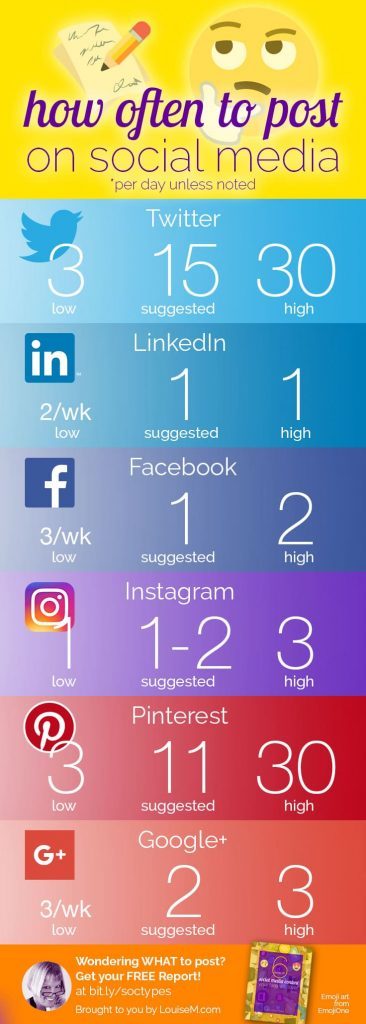
https://louisem.com/144557/often-post-social-media
If you notice, Twitter and Pinterest are the only sites that really stray away from the 1 to 3 post area. Twitter at its core is a social media platform focused on conversations. If you’re going to utilize Twitter for your business then you have to go in knowing and understanding that, thus leading you to post a bit more tweets in the form of regular tweets and replies. Pinterest at its core is a image sharing website that is maybe less formal than Instagram. Pinterest is like your businesses’ social bulletin board, it’s a place to post quick images and content that give snippets in to the life of your business.
With platforms like Pinterest and Twitter that involve a higher number of posting it is good to plan ahead what you will be posting and spread those posts out throughout the hours of the day. With other platforms that require less posting such as Facebook and Instagram it is important to post at times where the most people will see them.
When?
In 2018, Sprout Social found for Facebook that early evenings and early mornings had the lowest amount of engagement during the day, while weekdays from 10 am to 3 pm had the highest amount of engagement. They found that Saturday was the worst day of the entire week for social posting on Facebook and that Wednesday at 12-2 pm and Thursday at 1 to 2 pm were the best times of the whole week.
For Instagram they found the best times to post were Wednesday at 3 pm, Thursday at 5 am, 11 am, 3-4 pm, and Friday at 5 am. Pretty early times there! That is where a scheduling tool would do you some good! They found that most consistent and safest times to post to Instagram are Tuesday through Friday from 9 am to 6 pm, so you have a pretty wide window there.

There are different times and customs that are best for each platform. It is interesting how these numbers differ from one another. It gives some us some insight to how these platforms are inherently used by people which helps us analyze how we create our content for them.
A reason Instagram has such early times could be because people wake up for work and just scroll through the pictures on their feed. There isn’t a lot to digest with Instagram, it is just one picture at a time which makes it great for easy scrolling when you’re just waking up and passing the time while eating breakfast or drinking coffee. Facebook has better numbers in the middle of the day because that is probably when a lot of people are hitting that midday work wall and doing a little bit of social surfing. They are more awake now and don’t mind taking in a bit more content.
The post Social Media Posting For Business – When, What and How Much? appeared first on Apollo Marketing.
from Apollo Marketing http://bit.ly/2SgUpbJ via IFTTT
from WordPress https://searchengineoptimizationfrederick.wordpress.com/2019/01/31/social-media-posting-for-business-when-what-and-how-much/
0 notes
Text
6 Mobile Apps That Make Life A Little Easier
Today we are coming at you with another listicle (a list themed article). There are millions of mobile apps that can be downloaded on to your phone for your pleasure or convenience. With so many out there it can be easy for some really great ones to get lost in the shuffle. Our idea for this blog post was to create a list of apps that make certain tasks much more convenient by using them. Just apps that make your life a little bit easier, whether they help you in work, your personal life, your hobbies, or anywhere else.
Every once in awhile I personally go through my phone and organize all the apps I have. I choose which ones I want to keep depending on if I use them a lot and I choose which ones I want to delete based on if I haven’t really used them in awhile. The ones I keep typically all have one or two things in common; I use them almost daily, they make certain specific tasks much easier, or both! Going through all apps on your phone every once in awhile and asking yourself these questions is a habit I recommend!
With all these ideas in mind the list I’ve compiled below is basically a list that meets my personal standards of use. I would use and do use every one of the apps we’ve gathered for this list. I hope that you can find good use in them just as I do!
1. Microsoft Office Lens

Credit from cnet.com
I use the Microsoft Office Lens more than any of the other apps I use on this list. The Microsoft Office Lens app is a mobile replacement for a flatbed scanner that allows you to scan physical documents with the use of your phone’s camera lens. The app will create a digital copy of the scanned document that you can then edit, save to a PDF, photo, word, OneNote, or Powerpoint. You can also share it through email or any other apps your phone allows you to share from.
I can not stress the convenience of this app enough. It makes regular scanners pretty much obsolete as there is no drop off in quality and it is so easy to do to.
2. 1password

Credit to 1password.com
1password is an app that will keep all your passwords and other sensitive information in one protected place. Now we get it, if keeping all your information in one digital place makes you uncomfortable that is completely understandable. If that is the case then this app probably isn’t for you.
However, it is a convenient app for keeping and storing passwords, codes, and other important info in a place you’ll remember. You can log account passwords, addresses, credit/debit card numbers, locker combinations, routing numbers, wifi passwords, or any other pertinent info that you may need on a moments notice. For some people it may be better than hiding sticky notes around their house!
3. IFTTT
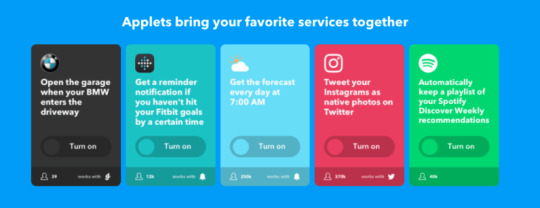
Credit to thenextweb.com
IFTTT was an app I had never heard of before doing research for this post. As soon as I read about it I downloaded it right away. IFTTT stands for “If this, then that” and I can’t stress enough how cool I think this app is. IFTTT allows you automate almost anything you want to in your digital world.
For example, I coach youth soccer on the side outside of work. We use an app called TeamSnap that is essentially a scheduling app that every family on my team can see and notify me on their availability. Using IFTTT I was able to set an automation between my TeamSnap account and my Google Calendar so now every time an event is added in to TeamSnap it automatically loads in to my Google Calendar.
IFTTT isn’t complicated either, it does all the heavy lifting for you. For me to set that first automation all I did was see it as a suggested automation based on the apps I use and turn it on. All I had to do was sign in to my Google and TeamSnap accounts and it was set up and ready to go.
This was just a basic automation too. There are so many other things IFTTT can do for you. It works to automate with all sorts of other smart devices including Amazon Alexa. The possibilities are pretty expansive. I haven’t stopped tinkering with it since downloading.
4. SignNow

SignNow is an app that allows you to sign documents anywhere on the go. If someone sends you a document that needs signing and you don’t have access to a printer or the time to go and print it out, sign it, and scan it back then SignNow is perfect for you. All you do is upload the document from where ever it is that you have it and you’ll be able to sign it with your finger and send it right on back out.
5. Awesome Note (+ToDo)

Credit to Pinterest.com
There are a ton of note taking and to-do list apps out there but I liked Awesome Note (+ToDo) for its simplicity and nice looking layout. Awesome Note lets you create beautiful and unique notes and lists with the ability to edit colors, background images, fonts, and icons. It isn’t just some rigid notes app but something that really pops of your phone’s screen while also being effective.
6. Converter+

Converter Plus’ greatness is all in its name. It is a calculation app that makes converting any type of measurement simple and easy. When we say any measurement, we really mean it. You can convert length, volumes, temperature, currencies, interest figures, and so much more. It is a one stop shop for converting numbers. Where you’re cooking something in the kitchen or flying to Belarus.
That is all for this list but we surely be making more like it soon! Hope that you found at least one these apps worth downloading, maybe even all of them!
The post 6 Mobile Apps That Make Life A Little Easier appeared first on Apollo Marketing.
from Apollo Marketing http://bit.ly/2DwIBtL via IFTTT
from WordPress https://searchengineoptimizationfrederick.wordpress.com/2019/01/24/6-mobile-apps-that-make-life-a-little-easier/
0 notes
Text
SEO, DIY or IOU?

Creating a strong presence online through SEO practices is a foundational stepping stone in the development of a business or company. When first starting a business you may not have the means to begin SEO right away or maybe you feel like your business isn’t ready yet. However, there will always come a certain time where you as a business owner will need to weigh your options in to how you can best develop a strong online presence in a manner that is smart and efficient for your business. Realistically, the sooner you begin building an online presence the better.
There are really two paths to beginning SEO practices and building up your businesses online presence. You can look into hiring a group of professionals such as ourselves (Yay!) or if you don’t think your business is quite ready for that yet you can look in to doing SEO yourself.
The truth is you don’t have to be a genius to perform some effective SEO practices for your business on your own, but you do also need time and a comprehension of certain principles. It becomes a matter of weighing the pros and cons and what you can handle on your end really. You need to decide for yourself what your business needs as compared to what you can shoulder on your own. We thought it might be helpful to list some factors that we feel are important to consider when deciding which path towards SEO you want to take!
1. SEO Takes Time
Performing local SEO on a website is not something that can be done in one fell swoop in one night, one week, or even one month. You build it up slowly over a course of several months and it is somewhat of a grind before you start seeing real results. You can get to the point down the road where once you’ve build a strong foundation you don’t have to spend as much time on it as you were in the beginning. It is kind of like water a plant. In the beginning it takes time for the plant to grow and bloom, but once it does you still need to water it a little each day for it to remain healthy.
2. SEO Requires a Willingness and Knowledge To Change Your Website
If you’re going to perform effective SEO then you need to be willing to make internal changes to your website. Once you are willing to make changes to your own website you are left with a decision. If you are familiar with the inner workings of your own site you can begin to make SEO focused changes yourself. If not, you can look for advice from experienced people or you can hire someone to make the changes for you. No matter what you have to ready and willing for your site to change, it is just a matter of whether you feel up to the task yourself or not.
3. You Have To Work On Things Other Than Your Website As Well
Your website is important to SEO. However, it isn’t just making changes to your website that matters when it comes to performing quality SEO. Things like online reviews, links that direct back to your website, and having your website placed in local listings is also important for building a good SEO footprint for your website. These things take time as well and the thing is too that your competitors will also be getting reviews, links, and listings. So you have to stay on top of these things in order to stay in the game.

4. Your Strongest Competitors Are Doing SEO Too
If your motivation for performing SEO is to get on level or get ahead of your competitors then you must go in knowing that whatever you are doing they are likely doing the same. You’re going to need the time to put in the work that is needed to keep up with everyone else. The main things that take time with SEO are building links back your website, managing and earning reviews, and creating quality content about your business for your website.
5. Opportunity Cost
Opportunity cost refers to the value a person could have received but passed up in pursuit of another option. Basically, if you are going to spend time as a business owner working on SEO for your website, what other business objectives would that be taking you away from? It is an important question to weigh as most business owners already have very big plates in front of them in the day to day running of your business.
If working on SEO will take more time than you need it to and will take you away from other important matters then maybe it is in your best interest to hire someone from the outside to take care of it. Or maybe you do have the time available you and it is within your reach. It is an important question to ask yourself.
6. Return On Investment
The last thing to consider is your potential return on investment between the two scenarios of developing SEO. By working on SEO yourself you could potentially be saving money by not paying an outside company to do the work, but you may also be losing money elsewhere as you are not able to focus on certain areas of your business as much given the attention SEO requires. Or maybe you’re in a situation where you won’t be losing any money in other places by giving attention to SEO.
On the flip side, by paying a little more for an outside company to come and do the work for you there is potential there to get a good return on investment as well. You’ll be able to give more attention to other things across your business and if you hire the right outside company to help you with SEO then you will certainly be making more money than you are paying.
All of these factors are worth considering when your business is at the point where SEO is a must. You don’t have to go in alone but maybe you can or want to. There is no wrong way to go about it! However, it is wise to weigh all your options equally and consider where you are and where you want to be. If you want to learn more about SEO and specifically about what SEO companies can do for you, visit our homepage at https://www.apollollc.org/
The post SEO, DIY or IOU? appeared first on Apollo Marketing.
from Apollo Marketing http://bit.ly/2FLgQjn via IFTTT
from WordPress https://searchengineoptimizationfrederick.wordpress.com/2019/01/23/seo-diy-or-iou/
0 notes
Text
First Google Algorithm Update of 2019 – What We Know So Far

Within the first week of January we started seeing some fluctuations across our different sites here at Apollo Marketing. Usually these fluctuations coincide with a Google algorithm update as we talked about in our Google dance article. To confirm these believes we started some research of our own to see if other marketers like us were experiencing the same issues. What we found was very helpful.
In our online search to see if other SEO people and companies were seeing the same google dance we were seeing on our sites we found three things. One was that other marketers were in fact seeing the same thing we were seeing with their own site numbers. This confirmed our beliefs that there had in fact been a Google update. The second find was a great article on Search Engine Land by Barry Schwartz discussing what everyone has been experiencing these past few weeks, and the third discovery was a great write up by Cognitive SEO by Adrian Cojocariu about what to do when experiencing these shifts in numbers.
What To Think? What To Do?
In the article Barry wrote, he used a number of different search engine tracking tools to see if they mirrored the ranking volatility that people around the SEO world have been experiencing. All of the tracking tools he used showed what could be described as uncommon changes in search result rankings. This was his way of confirming that there were in fact fluctuations happening across the web. He actually reached out to Google to see if they would confirm that they had indeed made changes to their algorithm but Google did not reply. This is actually somewhat commonplace though as Google is often making changes and usually does not publicly announce when they update unless it is a very large change. Which is where the difficulty lies in confirming what changes were actually made.
Barry also asked a few rhetorical questions that we feel are interesting ideas to think about. Basically, do these updates actually matter in the long run and is it really necessary to know about them? Barry’s point, and a point that we agree with, is that it is certainly helpful to know about these Google updates to know you’re not going crazy when your sites fluctuates. It is also helpful to know about them so you can take the right course of action to remain on the path of consistency with your website build. In the long run if you are consistently building out what you know to be a quality website while always looking to make improvements you will be just fine.

With this idea in mind is where Adrian’s great article comes in to play. Adrian wrote what he calls the Google Update Survival Guide. Essentially, what are the things you can do to make sure you are remaining consistent with your website build in the wake of a Google update. Adrian laid out eight steps for doing so. Follow the right sources, check your traffic positions, double check them, get in touch with an expert, audit your website, exclude other possibilities, develop a strategy, and keep doing the good SEO you have been doing. We would definitely recommend giving his article a read if you want some good detailed tips for navigating algorithm changes.
His steps can be broken up into segments of action. The first three are the segments of verification. Check trustworthy sources around the web for news on algorithm updates. Adrian mentions Search Engine Land, the website that Barry wrote his article for that we mentioned above, as a trustworthy source. Then the next two steps involve checking your own numbers to verify that you were affected by the change.
If you were indeed affected then the next segment to move forward in to involves steps four, five, and six. Seek out expert help if you’re not already an expert yourself on marketing and find out what it is that may need to be done. Run an audit on your website and exclude any other possibilities that way you know for certain what your next steps should be. After this segment the final segment involves developing a strategy and also staying the course. Find out what you need to fine tune and keep doing the things that you do well.
Keep Building
That is really just it. It is important to be aware of Google updates in order to make adjustments accordingly, but they are not the end all be all. If you do good work consistently and are proactive when changes are made, then good results will come.
As for this latest January Google update, while it seems there have definitely been fluctuations across many websites the exact changes themselves have not been pinpointed yet. There is still testing being done to see what content was bumped. Some people are experiencing their blog sites jumping up and down while others are having mobility issues with different sites. If you’re having ranking fluctuation, let us know so we can try to determine the cause!
The post First Google Algorithm Update of 2019 – What We Know So Far appeared first on Apollo Marketing.
from Apollo Marketing http://bit.ly/2CphejA via IFTTT
from WordPress https://searchengineoptimizationfrederick.wordpress.com/2019/01/17/first-google-algorithm-update-of-2019-what-we-know-so-far/
0 notes
Text
The Google Dance

The Google Dance is a term used to describe what search engine numbers and analytics do when google updates their search algorithm. Google’s search algorithm is the mechanism that Google uses to determine website rankings based on different factors about those websites. We have actually talked about Google’s search algorithm in the past in our SEO explainer article.
You see, no one actually knows the exact details of the algorithm and how it truly values and ranks certain aspects of websites. It is a SEO experts job to make educated guesses about what the algorithm values based on A/B testing and other types of research. The idea of SEO is to be very knowledgeable about how Google ranks their websites but no one holds the one true key to everything about the algorithm. One of the reasons no one knows exactly how the algorithm works is because Google changes it up every so often. They add value to new factors, take away value from certain factors, make big updates, make little updates, among many other things.
When there is an algorithm update, the rankings and numbers for websites get a little bit crazy and spike up and down for a periodic amount of time while everything readjusts to changes in the algorithm. AKA the Google dance. These spikes and dips can be big, small, long, and short. In the first few weeks of January we have actually noticed a little bit of Google dance happening on our sites and we thought there might be a possibility that Google updated their algorithm sometime in the early new year. We also figured now would be a great time to write a post about it.
Knowing that Google regularly updates their search algorithm is valuable knowledge from both a marketer and customer standpoint. As a customer, you should be wary of marketers or businesses that will try to sell you on get high rankings quick or guaranteeing first page search results. As we stated above, no one holds the key to unlocking Google’s search result secrets and anyone guaranteeing they can get specific results are likely not sincere.
From a marketers point of view it is important to know that Google updates their algorithm so you can be honest with your customers about what they can expect and what results you can bring to them. No one Google update will bring a marketing agency crashing down, but it is good to be aware of these updates in case adjustments need to be made.

In our online search to see if other SEO people and companies were seeing the same google dance we were seeing on our sites we found two things. One was that other people were seeing the same thing we were seeing with their own site numbers, and two was a great article on Search Engine Land by Barry Schwartz discussing what everyone has been experiencing these past few weeks.
Barry used a number of different search engine tracking tools to see if they mirrored the ranking volatility that people around the SEO world have been experiencing. All of the tracking tools he used showed what could be described as uncommon changes in search result rankings. He actually reached out to Google to see if they would confirm that they had indeed made changes to their algorithm but Google did not reply. This is actually somewhat commonplace though as Google is often making changes and usually does not publicly announce when they update unless it is a very large change.
Barry also asked a few rhetorical questions that we also feel are interesting ideas to think about. Basically, do these updates actually matter in the long run and is it really necessary to know about them? Barry’s point, and a point that we agree with and alluded to above when talking about a marketers point of view, is that it is certainly helpful to know about these Google updates to know you’re not going crazy when your sites fluctuates. However, in the long run it is less important. As long as you are consistently building out what you know to be quality website and always looking to make improvements and build it up then you will be just fine.
That is really just it. It is important to be aware of Google updates in order to make adjustments accordingly, but they are not the end all be all. If you do good work consistently, good results will come.
The post The Google Dance appeared first on Apollo Marketing.
from Apollo Marketing http://bit.ly/2T5Dy8Q via IFTTT
from WordPress https://searchengineoptimizationfrederick.wordpress.com/2019/01/16/the-google-dance/
0 notes